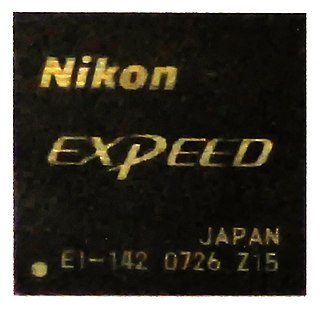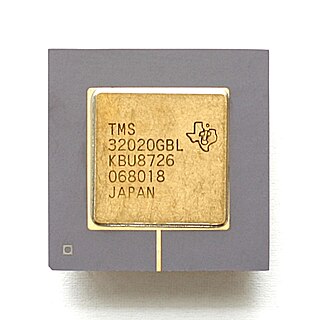 W
WA digital signal processor (DSP) is a specialized microprocessor chip, with its architecture optimized for the operational needs of digital signal processing. DSPs are fabricated on MOS integrated circuit chips. They are widely used in audio signal processing, telecommunications, digital image processing, radar, sonar and speech recognition systems, and in common consumer electronic devices such as mobile phones, disk drives and high-definition television (HDTV) products.
 W
WThe Blackfin is a family of 16-/32-bit microprocessors developed, manufactured and marketed by Analog Devices. The processors have built-in, fixed-point digital signal processor (DSP) functionality supplied by 16-bit multiply–accumulates (MACs), accompanied on-chip by a microcontroller. It was designed for a unified low-power processor architecture that can run operating systems while simultaneously handling complex numeric tasks such as real-time H.264 video encoding.
 W
WThe Fujitsu FR-V is one of the very few processors ever able to process both a very long instruction word (VLIW) and vector processor instructions at the same time, increasing throughput with high parallel computing while increasing performance per watt and hardware efficiency. The family was presented in 1999. Its design was influenced by the VPP500/5000 models of the Fujitsu VP/2000 vector processor supercomputer line.
 W
WAn image processor, also known as an image processing engine, image processing unit (IPU), or image signal processor (ISP), is a type of media processor or specialized digital signal processor (DSP) used for image processing, in digital cameras or other devices. Image processors often employ parallel computing even with SIMD or MIMD technologies to increase speed and efficiency. The digital image processing engine can perform a range of tasks. To increase the system integration on embedded devices, often it is a system on a chip with multi-core processor architecture.
 W
WThe IRCAM Signal Processing Workstation (ISPW) was a hardware DSP platform developed by IRCAM and the Ariel Corporation in the late 1980s. In French, the ISPW is referred to as the SIM. Eric Lindemann was the principal designer of the ISPW hardware as well as manager of the overall hardware/software effort.
 W
WThe Motorola DSP56000 is a family of digital signal processor (DSP) chips produced by Motorola Semiconductor starting in 1986 and is still being produced in more advanced models in the 2010s. The 56k series was quite popular for a time in a number of computers, including the NeXT, Atari Falcon030 and SGI Indigo workstations all using the 56001. Upgraded 56k versions are still used today in audio equipment, radars, communications devices and various other embedded DSP applications. The 56000 was also used as the basis for the updated 96000, which was not commercially successful.
 W
WThe Motorola 96XXX is a family of digital signal processor (DSP) chips produced by Motorola. They are based on the earlier Motorola 56000 and remain software compatible with them, but have been updated to a full single-precision (32-bit) floating point implementation.
 W
WThe MT6235 is a processor used in many Chinese cellular phones. It is a member of the MT62xx series of processors by MediaTek.
 W
WThe OMAP family, developed by Texas Instruments, was a series of image/video processors. They are proprietary system on chips (SoCs) for portable and mobile multimedia applications. OMAP devices generally include a general-purpose ARM architecture processor core plus one or more specialized co-processors. Earlier OMAP variants commonly featured a variant of the Texas Instruments TMS320 series digital signal processor.
 W
WSigmaTel was an American system-on-a-chip (SoC), electronics and software company headquartered in Austin, Texas, that designed AV media player/recorder SoCs, reference circuit boards, SoC software development kits built around a custom cooperative kernel and all SoC device drivers including USB mass storage and AV decoder DSP, media player/recorder apps, and controller chips for multifunction peripherals. SigmaTel became Austin's largest IPO as of 2003 when it became publicly traded on NASDAQ. The company was driven by a talented mix of electrical and computer engineers plus other professionals with semiconductor industry experience in Silicon Hills, the number two IC design region in the United States, after Silicon Valley.
 W
WThe Texas Instruments DaVinci is a family of system on a chip processors that are primarily used in embedded video and vision applications. Many of the processors in the family combine a DSP core based on the TMS320 C6000 VLIW DSP family and an ARM CPU core into a single system on chip. By using both a general-purpose processor and a DSP, the control and media portions can both be executed by processors that excel at their respective tasks.
 W
WTexas Instruments TMS320 is a blanket name for a series of digital signal processors (DSPs) from Texas Instruments. It was introduced on April 8, 1983 through the TMS32010 processor, which was then the fastest DSP on the market.
 W
WTriMedia is a family of very long instruction word media processors from NXP Semiconductors. TriMedia is a Harvard architecture CPU that features many DSP and SIMD operations to efficiently process audio and video data streams. For TriMedia processor optimal performance can be achieved by only programming in C/C++ as opposed to most other VLIW/DSP processors which require assembly language programming to achieve optimal performance. High-level programmability of TriMedia relies on the large uniform register file and the orthogonal instruction set, in which RISC-like operations can be scheduled independently of each other in the VLIW issue slots. Furthermore, TriMedia processors boast advanced caches supporting unaligned accesses without performance penalty, hardware and software data/instruction prefetch, allocate-on-write-miss, as well as collapsed load operations combining a traditional load with a 2-taps filter function. TriMedia development has been supported by various research studies on hardware cache coherency, multithreading and diverse accelerators to build scalable shared memory multiprocessor systems.
 W
WVideoCore is a low-power mobile multimedia processor originally developed by Alphamosaic Ltd and now owned by Broadcom. Its two-dimensional DSP architecture makes it flexible and efficient enough to decode a number of multimedia codecs in software while maintaining low power usage. The semiconductor intellectual property core has been found so far only on Broadcom SoCs.
 W
WXilleon is a brand for a family of SoCs combining a low-power CPU with ASICs for accelerated video decompression and further functions for major worldwide broadcast networks targeting digital television.
 W
WTexas Instruments TMS320 is a blanket name for a series of digital signal processors (DSPs) from Texas Instruments. It was introduced on April 8, 1983 through the TMS32010 processor, which was then the fastest DSP on the market.